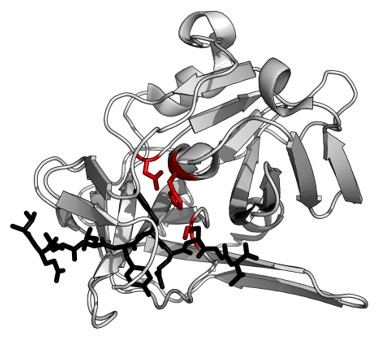Use Glycoenzymes to Understand Glycan Structure and Function
As a world-leading service provider, Creative Biolabs is fully committed to offering high-quality and low-cost services to advance glycoenzymes research based on our powerful technologies.
 Fig.1 Diagram of a protease complexed with its peptide substrate.1
Fig.1 Diagram of a protease complexed with its peptide substrate.1
Glycoenzymes play an irreplaceable role in the biosynthesis of all glycans and glycoconjugates. Because of this, glycoenzymes also provide a rich source of biocatalysts for industrial applications. Glycoenzymes can be found in a variety of biological materials, including plant tissues, animal organs, and microbial extracts. In addition, glycoenzymes contain covalently linked carbohydrate residues in their molecular structure.
Types of Glycoenzymes
In the study of the purification of glucosidase and invertase, it was found that highly purified samples of these enzymes contained carbohydrates. Carbohydrates often referred to as glycans. In fact, the essence of invertase is a glycoprotein, and effort has been devoted to the study of the carbohydrate composition of the enzyme. Some other carbohydrate hydrolases also contain carbohydrate moieties in their molecular structures, such as fungal superamylase, yeast glucoamylase, fungal yeast glucoamylase, and fungal glucosaminase.
Many nucleic acid hydrolases are usually present in mammalian tissues as isoenzymes. Some of these isoenzymes are glycoenzymes. Isoenzymes are not only different in carbohydrate content, but also in their amino acid composition. The genetic significance of controlling carbohydrase biosynthesis with changes in the amino acid composition is manifold.
Several enzymes in the oxidoreductase group are carbohydrases. Among them, glucose oxidase and chloroperoxidase have been studied in detail. Results showed that the types of monosaccharide residues in the carbohydrate portion of the studied carbohydrases and carbohydrases were similar.
Several lysosomal hydrolases in mammalian tissues also have glycogens. In addition, some other hydrolases are also glycoenymes such as plant proteases, phosphatases, and mammalian esterases. Among these glycoenymes, only the properties of carbohydrate components in proteases have been extensively studied.
Use Glycoenzymes to Understand Glycan Structure and Function
Glycosylation is a common post-translational modification that can modify most expressed proteins and regulate their functions. Hundreds of glycoenymes are involved in the biosynthesis of cellular glycans. Any mutation of glycoenymes may cause severe morphological and developmental defects or even death in invertebrates. Many efforts have been devoted to the functions of the carbohydrate part of glycoenymes. The function of this part can be divided into two categories: biological and structural. The role of carbohydrate residues in the transport of carbohydrate enzymes and glycoproteins through cell membranes is based on the phenomenon that many cellular proteins secreted from cells are glycoproteins, while those remaining in cells are not glycoproteins. The second biological function of carbohydrates is related to immune response. Glycoproteins present on the cell membrane surface and glycoproteins secreted by cells both function as antigenic substances. Furthermore, glycans on the surface of bacterial cells are important antigens.
Over several years, Creative Biolabs has been a world leader in the glycoenymes analysis field. With dedicated scientists and advanced knowledge of glycoenymes, Creative Biolabs focuses on advancing glycoenymes technology to solve challenges in carbohydrase research. For more detailed information, please feel free to contact us.
Reference
-
Image retrieved from https://commons.wikimedia.org/wiki/File:TEV_protease_summary.png, Thomas, 2013, used under CC BY 4.0, without any modification.
For Research Use Only.
Resources

 Fig.1 Diagram of a protease complexed with its peptide substrate.1
Fig.1 Diagram of a protease complexed with its peptide substrate.1


